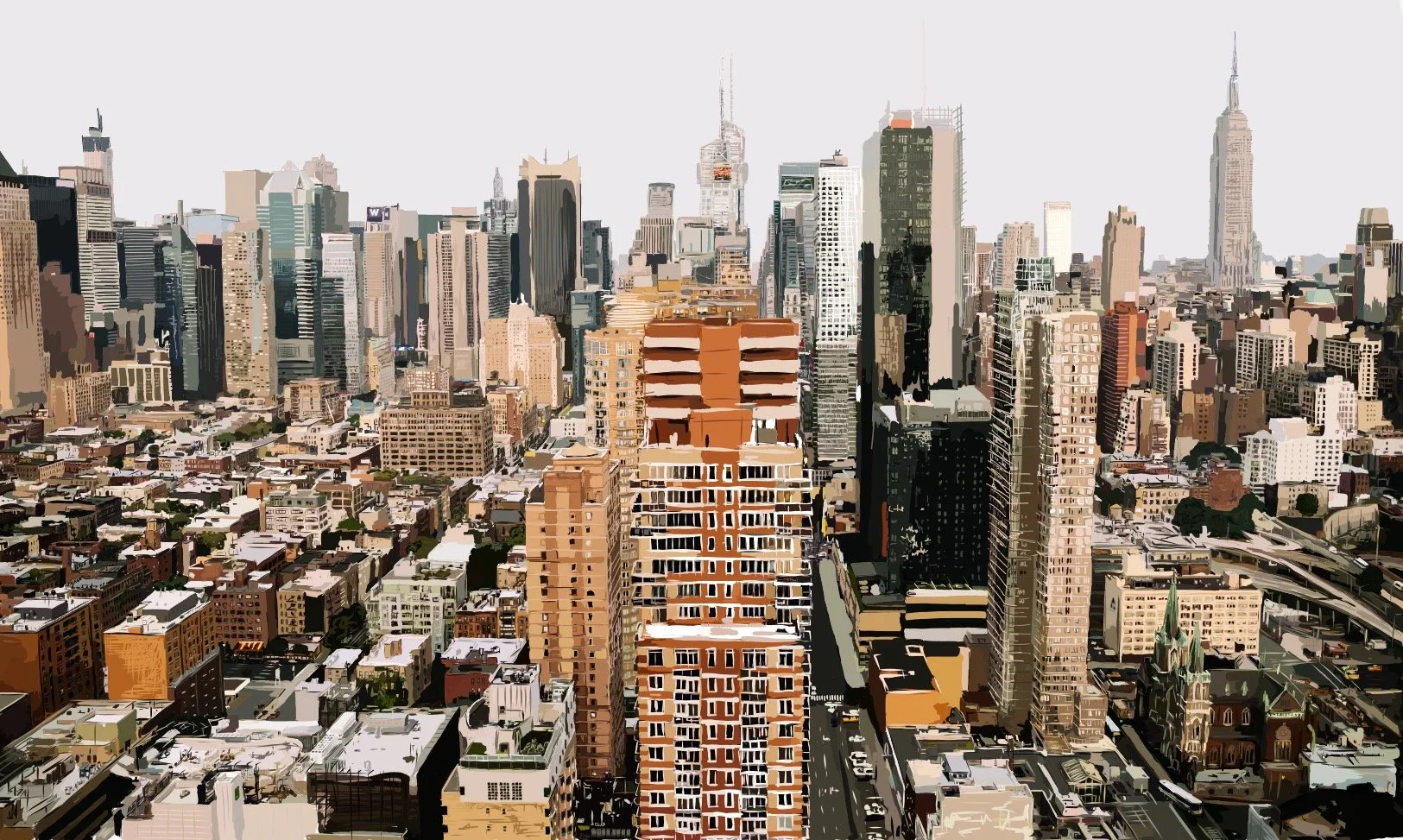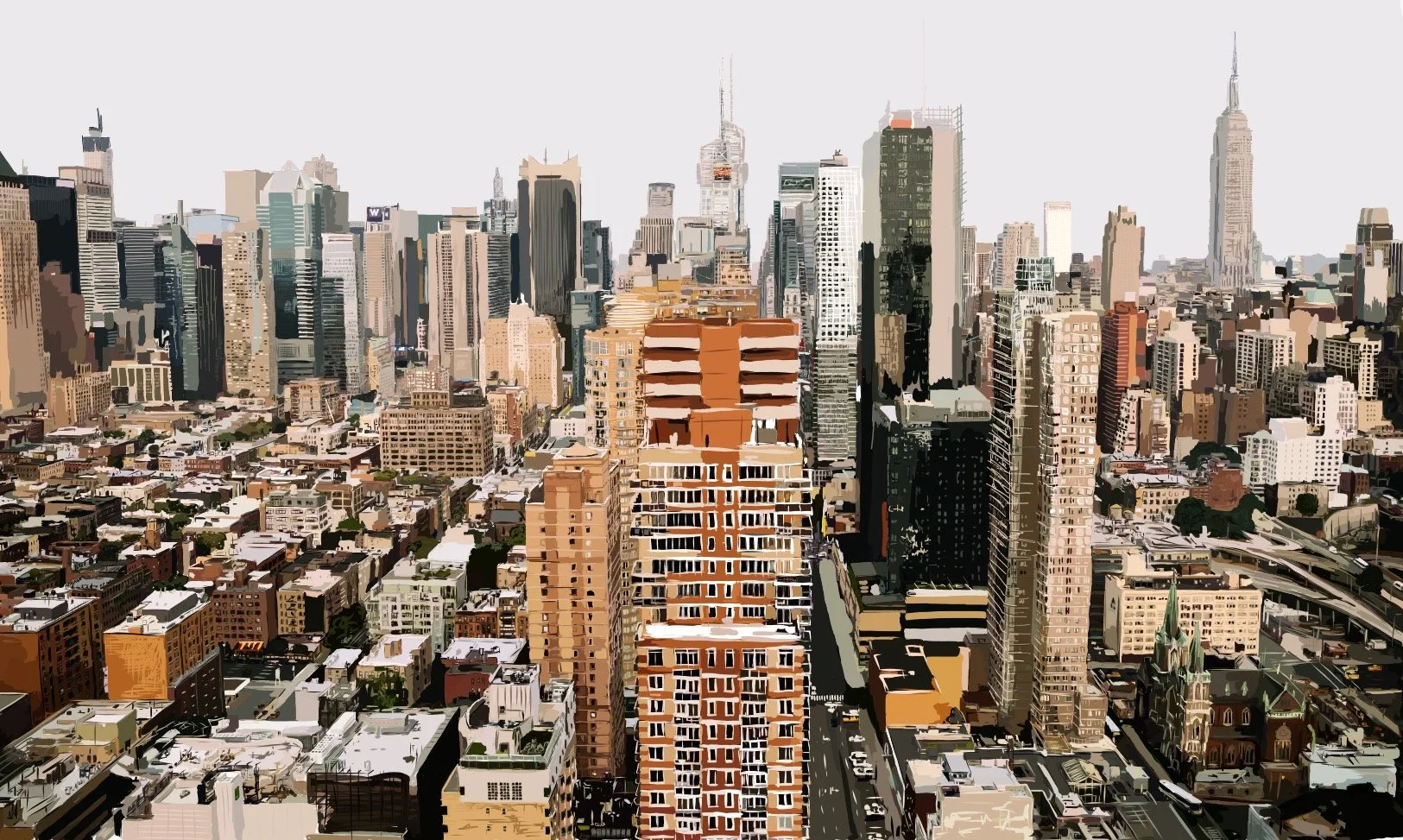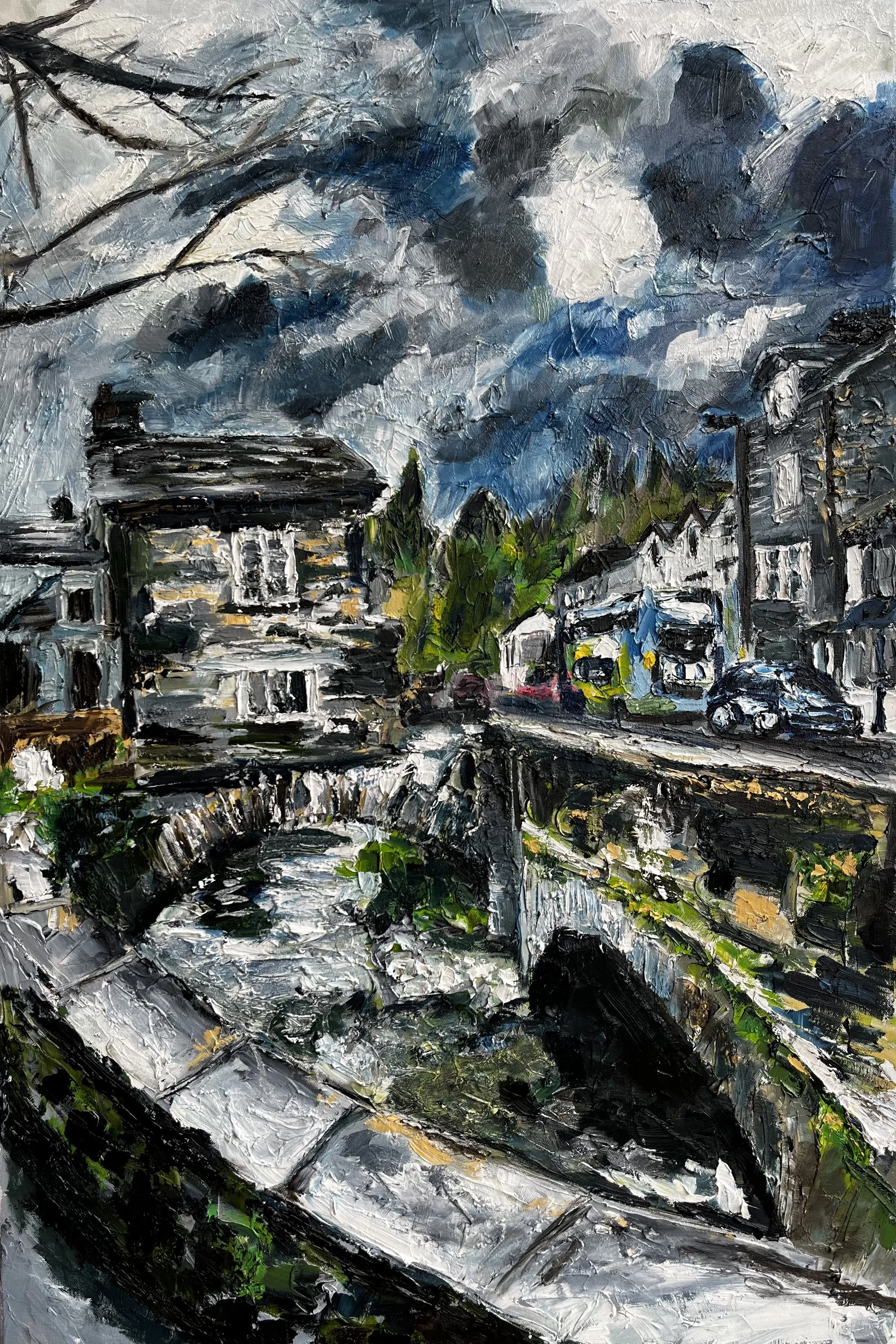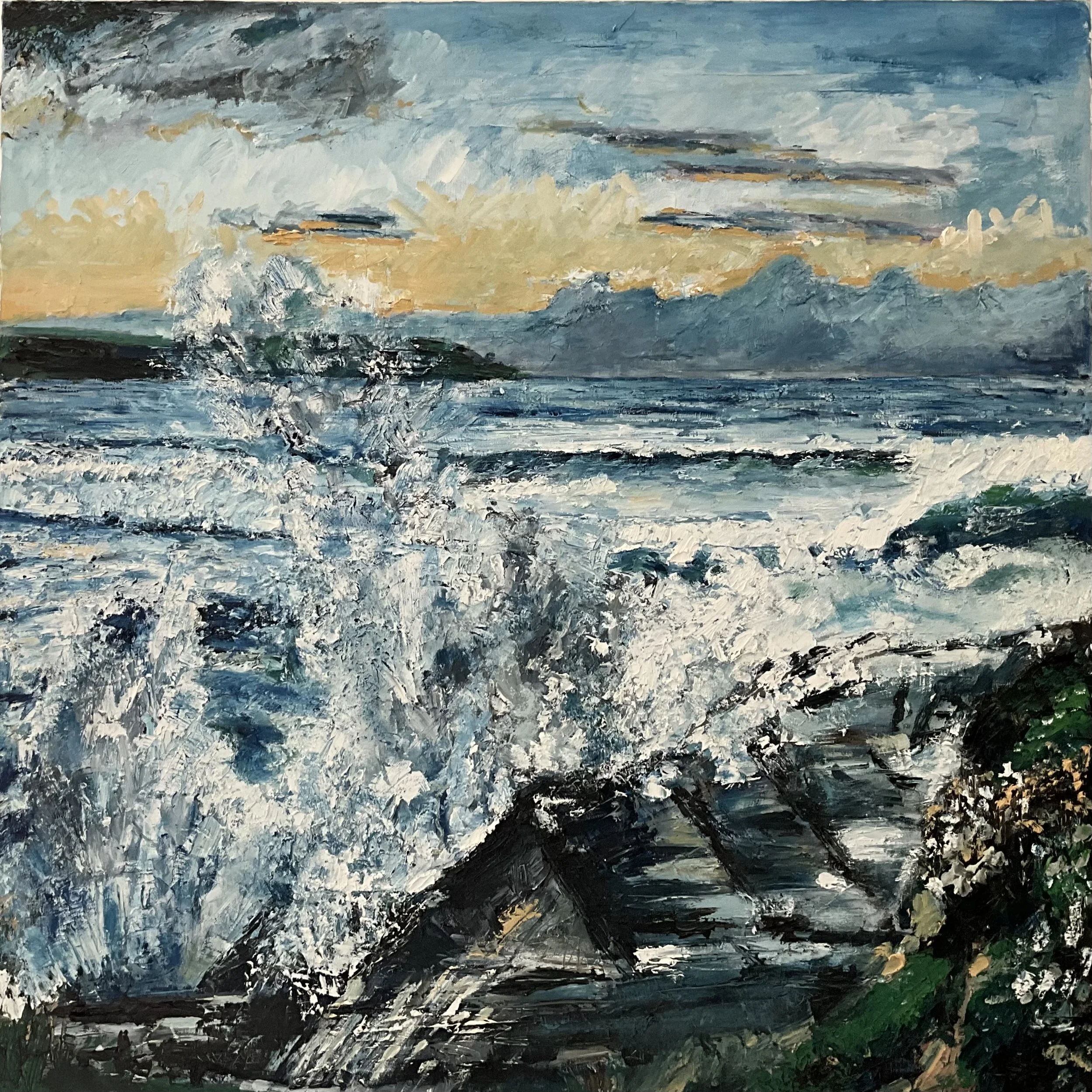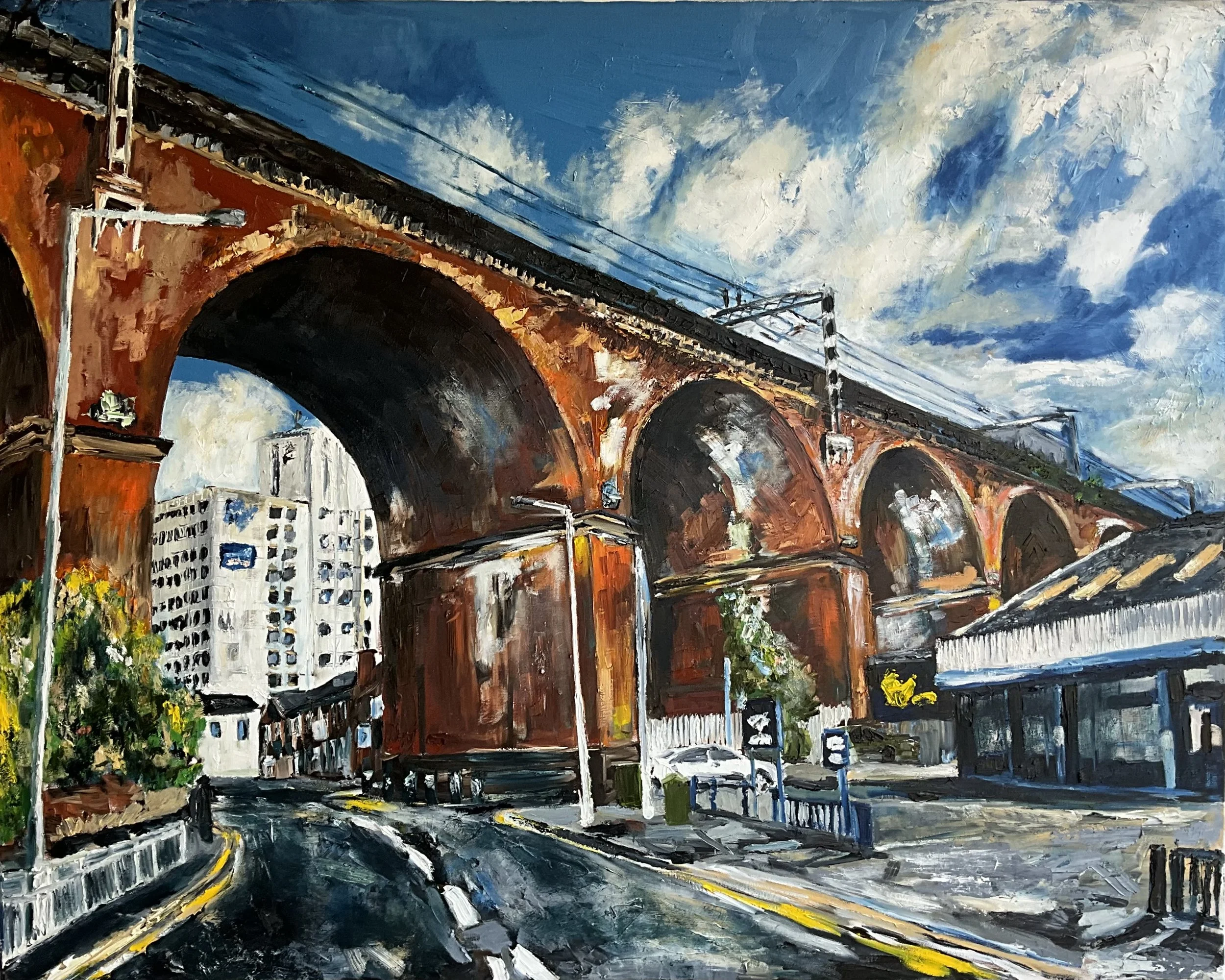New York New York
A City in Marks: Chaz Newton-Smith’s Hand-Drawn New York
After being made redundant from a part-time youth work role, Stockport artist Chaz Newton-Smith turned fully to art, creating an intricate hand-drawn digital piece of New York City. Made using only his finger on Adobe Draw (now Adobe Fresco), the work took over 100 hours and captures the dense energy of the skyline, with the Empire State Building standing proudly in the distance. From afar, it appears photographic, but up close, the piece reveals thousands of expressive marks, layering the city in abstraction and movement. Designed as a vector, it can be printed at any size without losing its detail. Newton-Smith’s dedication drew the attention of Adobe’s developers, impressed by his craftsmanship. In an age of instant digital production, his patient, mark-by-mark technique offers a refreshing, humanised portrait of New York—one that resonates with the spirit of both classic New York artists and contemporary digital creators.
A City in Marks: Chaz Newton-Smith’s Hand-Drawn New York
In today’s world of speed and automation, Chaz Newton-Smith’s way of working feels refreshingly different. Eight years ago, after losing a part-time job as a youth worker—a role he valued—Newton-Smith found himself at a turning point. Trained as an artist but long working outside the studio, redundancy gave him something rare: time. He used it to dive fully into his art.
One of the first major works from this new chapter is his digital drawing of New York City. Made entirely by hand in Adobe Draw (now Adobe Fresco), the piece looks almost photographic at first glance. The wide city view stretches across the skyline, leading the eye toward the Empire State Building. It’s the New York so many artists—Edward Hopper among them—have tried to capture: vast, restless, and alive.
But look closer, and the illusion changes. What first appeared as photographic detail becomes a web of marks, each placed one by one with Newton-Smith’s finger, long before the Apple Pencil existed. Layered and angled, the marks reveal a very different city—one built not from pixels, but from patience and human touch.
The drawing took over 100 hours to complete, a marathon of focus that echoes the energy of New York itself. Every building, every shadow, every reflective surface was drawn by hand. Because the work is a vector, it can be printed at any size—from a postcard to a billboard—without losing its detail or intimacy.
When Newton-Smith shared the piece on Twitter, it caught attention quickly. Adobe, including the lead developer of Adobe Draw, reached out to ask how he had achieved it with their tools. It was a small but telling moment: proof that even in the fast churn of digital art, patience and vision still stand out.
From his base in Stockport, England, Newton-Smith joins a long line of artists drawn to New York’s architecture as both subject and metaphor. His New York is not a glossy postcard and not a gritty cliché. Instead, it’s alive with contrasts—the monumental and the human, the overwhelming scale of the city and the fragile marks that hold it together.
At a time when AI can generate a cityscape in seconds, Newton-Smith’s drawing feels almost radical. It reminds us that both cities and works of art are made the same way: one mark at a time.
Chaz Newton-Smith
It all begins with an idea.
Introducing Chaz Newton-Smith
Born in Bristol in 1982, Chaz Newton-Smith is an artist whose bold, expressive work captures both the pulse of city life and the calm of the natural world. He studied Fine Art at the University of Northampton before moving to Manchester in 2005. He later settled in Stockport, where he continues to develop his distinctive style of abstract expressionism.
Chaz’s large-scale paintings take more than a month to complete. He layers brushstrokes, textures, and vivid colors to create works alive with energy and movement. His art is inspired by the Abstract Expressionist masters: the raw emotion of Franz Kline, the sweeping gestures of Willem de Kooning, and the fearless use of color by Claude Monet. While influenced by these greats, Chaz pushes his own practice forward—balancing architectural form with human feeling in every canvas.
His story also carries deep personal struggle. In December 2018, Chaz suffered a severe brain injury after being struck by a vehicle. Years of rehabilitation followed, yet his drive to create never faltered. This experience transformed his art, giving it new layers of resilience, expression, and life.
Today, Chaz exhibits his work at The Springfield House Gallery. The gallery combines historic character with a contemporary spirit, offering the ideal space for his bold, emotive paintings.
Step into the collection and experience the art of Chaz Newton-Smith—where every brushstroke carries a story of endurance and passion.
A weekend away at the lake district
It all begins with an idea.
A Weekend in the Lake District: Inspiration at The Inn at Grasmere
Sometimes, a change of scenery is all it takes to spark new ideas. For Chaz Newton-Smith and his wife, Sarah, that moment came during a rare weekend escape to the Lake District. Away from the bustle of family life, they found peace, space, and inspiration.
Their retreat was The Inn at Grasmere, a welcoming spot in the heart of one of England’s most striking landscapes. With its cosy rooms, sweeping views, and warm hospitality, it offered the perfect base for rest, long walks, and a touch of artistic renewal.
As they explored Grasmere and Ambleside, Sarah, captivated by the misty hills and shimmering waters, turned to Chaz and declared:
“You should paint this!”
Chaz—already observing the landscapes with an artist’s eye—responded with his trademark “Ranger face,” a quiet smile that mixed amusement with agreement. The idea settled, ready to take root.
Back in his Stockport studio, inspiration came to life. Chaz created three vivid paintings of the river in Ambleside, each alive with the force of rushing water and the enduring beauty of the fells. One piece even features the House Over the River, a beloved local landmark that lends history and charm to the scene.
That single weekend away became more than rest—it became a spark. Today, those three paintings are on display at The Springfield House Gallery, where Chaz’s bold, expressive style brings Ambleside’s landscapes into vivid focus.
Want to see them for yourself? Book an appointment and experience the inspiration first-hand.
The Harlyn Bay paintings
It all begins with an idea.
The Harlyn Bay Paintings
In August 2020, during a pause in the Covid lockdowns, Chaz Newton-Smith and his family spent a week in Harlyn Bay, Cornwall. The trip was a much-needed change of pace and a chance to recharge. At the time, Chaz was still recovering from a serious accident the year before. Though he had begun to regain strength, painting was slower than it used to be.
One stormy evening, Sarah—Chaz’s wife—suggested he head out to photograph the crashing waves. He followed her advice, capturing images filled with movement and energy. Those photos became the starting point for his first major works since the accident.
Back home in Stockport, Chaz worked from a small kitchen at the back of a carpentry studio, a space kindly lent to him. It wasn’t perfect, but it gave him room to paint again. Using his Cornwall photographs, he began creating three paintings, each exploring the wild force of the sea.
The Painting Process
These works took longer than his usual pace, as Chaz adjusted to a slower rhythm during recovery. Yet his style stayed true: bold brushstrokes, thick textures, and vivid colour. Rather than offering a literal view of Harlyn Bay, the paintings captured the storm’s energy—the deep blues, foamy whites, and dark rocky forms pulling the viewer into the drama of the waves.
The Harlyn Bay Series at The Springfield House Gallery
For Chaz, these three paintings marked a turning point, helping him return to painting more regularly. Today, they hang at The Springfield House Gallery, where visitors can see how a week in Cornwall shaped the next chapter of his artistic journey.
Want to see them up close? Book an appointment and experience the Harlyn Bay series in person.
The Stockport Viaduct: A Landmark in Art and History
It all begins with an idea.
The Stockport Viaduct: A Landmark in Art and History
The Stockport Viaduct is one of the most recognisable landmarks in the North West of England. Built between 1839 and 1840, it was a major feat of engineering and is still one of the largest brick structures in the UK. Standing 111 feet tall and stretching over 1,800 feet, the viaduct carries the Manchester to Birmingham railway across the River Mersey. With its 27 arches and striking red-brick design, it has become a lasting symbol of Stockport’s industrial past.
The Viaduct in Art
For almost two centuries, the viaduct has inspired artists who were drawn to its scale and presence. L.S. Lowry painted it in 1960, showing the structure in his trademark industrial style, with muted tones and bustling figures in the foreground. It also appeared in the works of Frederick William Jackson, the Manchester-born landscape painter. With its size, form, and character, the viaduct continues to attract artists who want to capture both architectural strength and the life of the town around it.
Chaz Newton-Smith’s Approach
For Chaz Newton-Smith, the Stockport Viaduct was a natural subject. Known for his expressive, abstract style, he was struck by how the viaduct towers over the skyline yet blends into the daily rhythm of Stockport. Instead of aiming for exact detail, he focused on mood and movement—the trains passing through, light shifting across the red brick, and the changing skies above.
Chaz used bold, textured brushstrokes to bring the scene to life. His work highlights the drama of light and weather, turning the viaduct into something dynamic rather than static. In this way, his paintings follow in the tradition of Lowry but with a modern, expressive twist.
See the Viaduct at The Springfield House Gallery
Chaz’s Stockport Viaduct paintings are now on show at The Springfield House Gallery, alongside other works that explore the character of Stockport and Manchester.
Want to experience them up close? Book an appointment to visit the gallery.

